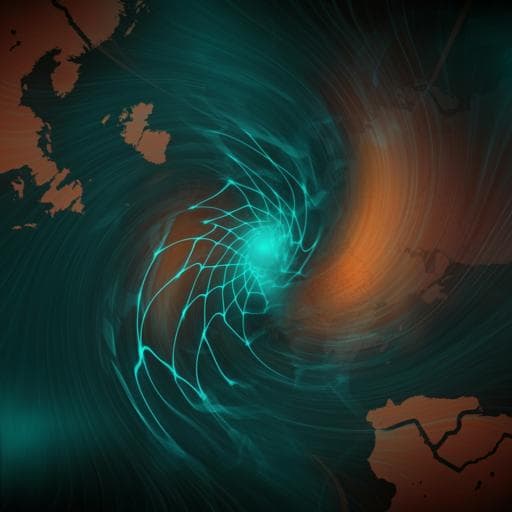
Medicine and Health
Contribution of climate change to the spatial expansion of West Nile virus in Europe
D. Erazo, L. Grant, et al.
This groundbreaking research explores the impact of climate change on the spread of West Nile virus in Europe, revealing how ecological suitable areas for the virus are significantly increasing. Conducted by a team of experts, this study highlights the urgent need to understand climate influences on public health risks.
~3 min • Beginner • English
Introduction
The study addresses whether and to what extent climate change has contributed to the spatial expansion and increased ecological suitability of West Nile virus (WNV) circulation in Europe. WNV is a mosquito-borne virus maintained in bird–mosquito cycles with humans as incidental dead-end hosts. Climate change is altering temperature, precipitation, and humidity patterns that influence mosquito and pathogen biology, potentially shifting geographic risk. Prior work links WNV occurrence to warm springs and summers, drought, and warm winters, but the causal attribution of observed long-term changes to climate change remains unclear. Using the IPCC attribution framework, the authors aim to quantify the contribution of observed long-term climate change to WNV expansion by comparing modelled suitability under historical (factual) climate with a counterfactual climate time series where long-term trends are removed, while controlling for non-climatic drivers such as land-use and population changes.
Literature Review
Previous studies have documented strong associations between WNV occurrence and environmental conditions: high spring and summer temperatures, summer droughts, and warm winters have been linked to outbreaks in Europe. Determinants including higher spring/summer temperatures, lower water availability, and drier winters have been highlighted. Land-use changes such as irrigated croplands and fragmented forests can favour outbreaks by enhancing vector–host contact, and standing water bodies support mosquito breeding and bird–mosquito sympatry. Biodiversity changes, particularly avian diversity, may modulate transmission by altering vector–host encounter rates, though evidence is mixed. While weather sensitivity is well established, the degree to which long-term climate change (as opposed to interannual weather variability and other anthropogenic factors) drives observed spatial changes in WNV risk had not been quantified. The IPCC AR6 WG2 provides a formal framework for impact attribution through comparison with counterfactual baselines, motivating this study’s approach.
Methodology
- Study design: Impact attribution of WNV ecological suitability to climate change using ecological niche models with a factual–counterfactual climate comparison consistent with IPCC WG2.
- Spatial unit: European NUTS3 administrative polygons; an optimised NUTS map was used to homogenise polygon sizes (VectorNet standard).
- Data sources and period:
• WNV human infections (presence/absence) aggregated at NUTS3 from ECDC TESSy for 2007–2019.
• Climate data (daily near-surface air temperature, precipitation, relative humidity) from ISIMIP3a reanalysis datasets, provided as factual and counterfactual versions (detrended to remove long-term climate change signal while preserving daily variability). Seasonal aggregates (DJF, MAM, JJA, SON) computed as 20-year means.
• Land-use data from LUH2: primary forest, primary non-forest, secondary forest, secondary non-forest, croplands, rangelands/pastures.
• Human population: gridded, log10-transformed, normalised by polygon area.
- Climate reanalyses used for training and projection:
• GSWP3-W5E5 (priority ISIMIP3a forcing), 20CRv3, 20CRv3-ERA5, 20CRv3-W5E5; each with corresponding counterfactual series generated using ATTRICI detrending.
- Response variable: Binary presence/absence at NUTS3 defined as detection of at least one confirmed, non-imported human case during 2007–2019. Areas with zero cases treated as pseudo-absences.
- Modelling approach: Boosted Regression Trees (BRT; Bernoulli) via R package dismo. Ten independent models per reanalysis dataset.
• Parameters: tree complexity = 5, learning rate = 0.005, step size = 10. Sensitivity checks on parameters showed stable performance.
• Cross-validation: Spatial k-fold (5 folds) using blockCV to mitigate spatial autocorrelation.
- Model evaluation: AUC and prevalence–pseudoabsence-calibrated Sørensen’s index (Slppc), optimising thresholds (0–1, step 0.01) for Slppc.
- Variable importance and response: Relative influence (RI) computed; partial response curves examined.
- Historical projections: Trained models projected to past (1901–1999) and present (2000–2019) environmental conditions for both factual and counterfactual climates. Non-climatic variables (land use, population) followed observed histories.
- Population at risk: Estimated total population residing in polygons exceeding ecological suitability thresholds (0.1 and 0.5) over time under both climates.
- Sensitivity analyses: Varied pseudo-absence sampling intensity (50%, 75%, 100% of eligible polygons), retrained 100 models for subsampled scenarios; trends compared to main analysis.
- Software: R 4.0.2; code available on GitHub repository.
Key Findings
- Model performance: All BRT models achieved strong predictive skill with AUC and Slppc > 0.8 (average Slppc > 0.83).
- Variable importance (GSWP3-W5E5 factual training): Highest RI from summer near-surface air temperature (16.3%), winter air temperature (10.5%), winter relative humidity (10.1%), summer precipitation (8.5%), and autumn relative humidity (7.5%). Land-use factors with notable RI included managed pastures/rangeland (7.1%), secondary non-forest (4.8%), and croplands (4.8%). Similar patterns held across alternative reanalyses.
- Response relationships:
• Positive associations: summer air temperature (notable increase in suitability above ~−20 °C as reported in unit scale used), summer precipitation (> ~2.2 kg/m²/day), cropland density (> ~20%).
• Negative associations: winter air temperature (> ~4–5 °C), winter relative humidity (> ~83–84%), managed pasture/rangeland density (> ~10%).
- Spatial–temporal suitability under factual climate (GSWP3-W5E5): Marked increases in WNV ecological suitability from the 1980s onward, especially in northern Italy, the Carpathians, lowlands in Hungary and eastern Romania, and the Aegean region in eastern Greece.
- Counterfactual climate: Little to no increase in ecological suitability across 1901–2019, indicating the observed rise is largely absent without long-term climate change.
- Cross-dataset robustness: Differences between factual and counterfactual projections were evident for GSWP3-W5E5 and 20CRv3-W5E5 (and to some extent 20CRv3-ERA5), but not for raw 20CRv3, which is considered more uncertain for present-day conditions; in 20CRv3, winter relative humidity showed minimal long-term change.
- Drivers of change: Decreasing winter relative humidity (negatively associated with suitability) and increasing summer temperatures (positively associated) emerged as key contributors to increased suitability.
- Population at risk:
• Using threshold ES ≥ 0.1 (GSWP3-W5E5): Historical population at risk nearly doubled relative to the counterfactual by the early 21st century.
• Using threshold ES ≥ 0.5 (GSWP3-W5E5): Historical population at risk increased by nearly sixfold versus counterfactual at present day.
• In counterfactual runs, increases in exposed population were driven largely by population growth rather than climate.
• Other reanalyses showed qualitatively similar but less pronounced divergence between factual and counterfactual estimates.
Discussion
The study provides formal attribution of the observed spatial expansion and increased ecological suitability of WNV in Europe to long-term climate change. By contrasting projections under factual versus detrended (no-climate-change) counterfactual climates while holding other environmental changes constant, the analysis demonstrates that the emergence of contemporary WNV hotspots—particularly from the 1980s in regions of southern and south-eastern Europe—aligns with rapid regional warming. The strong positive influence of summer temperature and negative influence of winter relative humidity are consistent with mechanistic understandings of vector and virus thermal biology and with prior empirical studies linking warm conditions and certain moisture regimes to WNV transmission. The findings indicate that climate change has been a critical driver of both the expansion of climatically suitable areas and the increase in human populations residing within them, beyond the effects of population growth and land-use change alone. While variability across reanalysis products introduces uncertainty, three of four datasets corroborate the attribution signal. These results underscore the significance of climate change for infectious disease risk in Europe and support the need for climate-informed surveillance, early warning, and targeted interventions in emerging hotspots.
Conclusion
Using an IPCC-consistent attribution framework with ISIMIP factual and counterfactual climate data, the study shows that climate change has substantially increased the ecological suitability for WNV circulation in Europe since the 1980s and has contributed to a marked rise in the population at risk. The analysis identifies summer warming and reductions in winter relative humidity as key climatic drivers, alongside contributions from land-use patterns such as cropland density. The work bridges climate science and spatial epidemiology by demonstrating a robust approach to impact attribution for vector-borne diseases. Future research should: (i) extend attribution to explicit anthropogenic forcing using climate model ensembles; (ii) integrate detailed biotic data (vector and avian hosts) and finer-grained land-use metrics; (iii) update models with recent occurrence data; and (iv) project future suitability under alternative climate and socioeconomic scenarios to inform surveillance and public health planning.
Limitations
- Biotic data gaps: Lack of century-scale, high-resolution data on mosquito vectors and avian hosts prevented inclusion of explicit biotic predictors; modelling them separately would risk circularity with overlapping environmental drivers.
- Land-use detail: Land-use predictors were limited to LUH2 categories available in ISIMIP, precluding inclusion of finer land-use diversity metrics that may influence mosquito–bird interactions.
- Response variable: Presence/absence based on at least one reported human case was used to mitigate surveillance heterogeneity; this sacrifices incidence information and assumes at least minimal vector abundance implicitly.
- Attribution scope: Counterfactuals remove observed long-term climate trends irrespective of cause; thus, attribution is to climate change broadly rather than directly to anthropogenic forcings (although anthropogenic warming in Europe is well established).
- Temporal coverage: Models were trained on data up to 2019 to match ISIMIP availability, excluding more recent occurrences (e.g., Netherlands, southern Spain), which were not highlighted as highly suitable by the model and warrant future updates.
- Reanalysis uncertainty: Differences across climate reanalyses (notably the raw 20CRv3) affect the strength of the attribution signal, reflecting dataset-specific uncertainties in trends (e.g., winter relative humidity).
Related Publications
Explore these studies to deepen your understanding of the subject.







